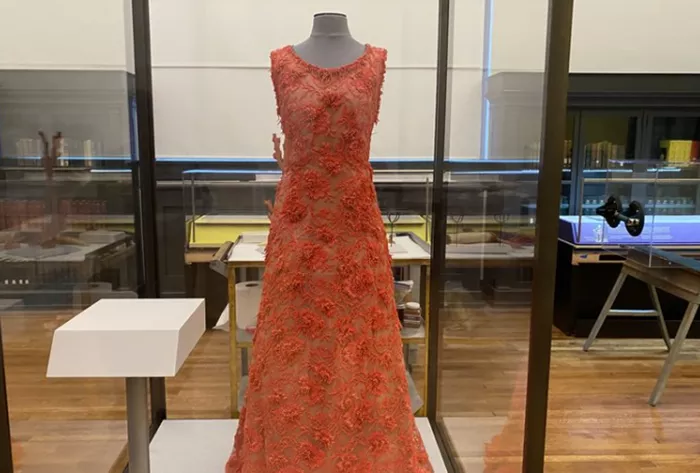A new exhibit at the Academy of Natural Sciences, Ecology of Fashion, is bringing attention to the environmental cost of the fashion industry. The exhibit blends high-end fashion with sobering facts about textile production, aiming to inspire visitors to think more critically about sustainability in fashion.
Opening on Saturday, the exhibit features a unique juxtaposition: luxurious designer garments adorned with feathers and sequins sit alongside piles of unwanted secondhand clothing. This contrast is designed to spark conversations about overconsumption and its impact on the planet.
“We want to surprise, delight, alarm, and ultimately inspire change,” said Marina McDougall, Vice President of Experience and Engagement at the Academy of Natural Sciences.
The first thing visitors encounter is a pile of unsold clothing from Plato’s Closet thrift shop in Paoli, accompanied by a sign highlighting the scale of the fashion consumption problem. The sign points out that there are already enough clothes in the world to clothe the next six generations. The exhibit implies that shopping secondhand alone will not solve the issue of overproduction.
Ecology of Fashion is divided into thematic sections on flora, fauna, fungi, and fossil fuels. Some garments are directly inspired by these themes, such as a bucket hat made from mycelium (mushroom strands), while others take a more interpretive approach. For example, a leopard print on a Halston silk pantsuit is made from PVC plastic.
While no animals were harmed in the making of this Halston suit, the exhibit explores how fashion trends have endangered animal populations. A standout feature is a 1962 leopard-skin coat worn by Jacqueline Kennedy during a visit to India. The coat sparked a fashion craze, and it’s estimated that 250,000 leopards were killed to meet demand for similar garments. The impact was so severe that Oleg Cassini, the designer of the coat, later became an advocate for faux fur.
Another highlight of the exhibit is a Givenchy dress that once belonged to Grace Kelly. The gown, featuring intricate embroidery and coral branches, creates a unique auditory experience as the coral pieces move when the wearer shifts. Clare Sauro, director of the Robert and Penny Fox Historic Costume Collection, explained, “It tinkles. It makes the most delightful noise when it moves. So it must have been really lovely to wear.”
Halfway through the exhibit’s run, some items from the Fox Historic Costume Collection, including Kelly’s gown, will be swapped out for conservation reasons. The replacement pieces will explore similar themes, with one of the new additions being a 2006 Oscar de la Renta dress covered entirely in pheasant feathers.
In addition to showcasing fashion’s environmental toll, the exhibit also offers ways visitors can reduce their impact. Throughout its run, which lasts until August 31, 2025, workshops and demonstrations on sustainable practices will be hosted by organizations like the PA Flax Project.
The curators hope visitors will leave the exhibit not with feelings of guilt, but with a greater sense of awareness and inspiration. While the fashion industry certainly poses challenges, they argue, there’s also a deep human connection to clothing. “It’s OK to want beautiful things,” said Sauro. “Fashion is primal. It’s universal. There are no easy answers.”
Related topics:









